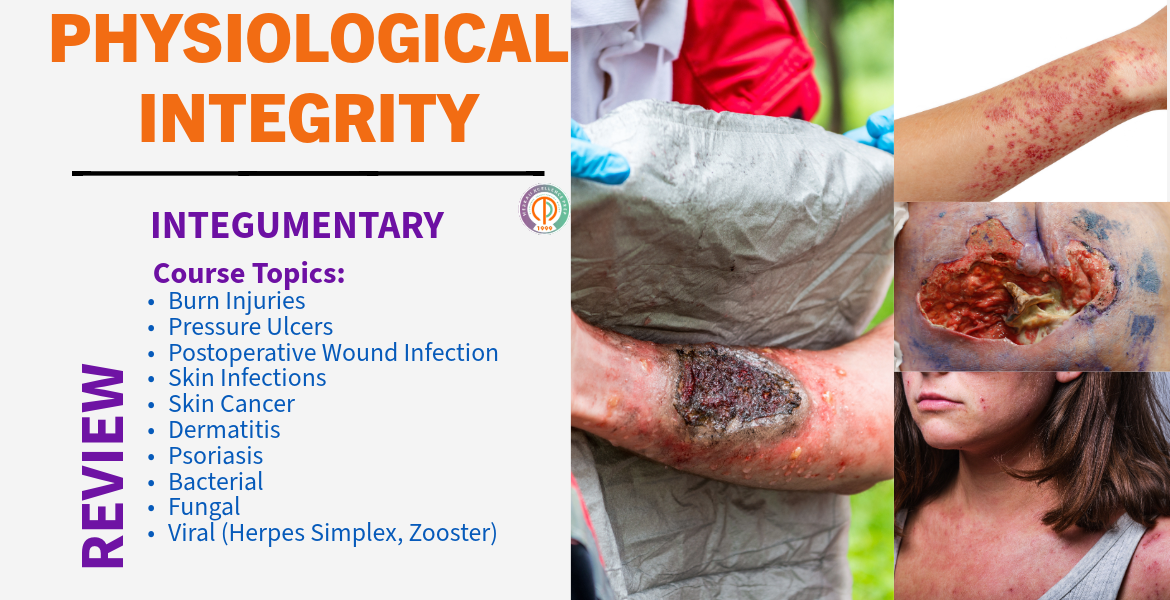
PHYSIOLOGICAL INTEGRITY

PHYSIOLOGICAL ADAPTATION: Cardiovascular I - Peripheral Vascular Disorder
$ 64.99
Prep-Course(on-demand)
INTEGUMENTARY SYSTEM NURSING CARE: Assessment, Management, and Prevention
$ 64.99
Prep-Course(on-demand)
This comprehensive course explores the physiology, pathology, and evidence‑based nursing management of integumentary disorders across the lifespan.
Students will delve into ten critical focus areas—burn injuries; pressure ulcers; postoperative wound infections; skin infections; skin cancer; dermatitis; psoriasis; bacterial, fungal, and viral (Herpes Simplex & Zoster) infections—through a blend of didactic lectures, case‑based discussions, and clinical simulations.
Emphasis is placed on holistic assessment, prioritized decision‑making (PRIORITY‑X), SMARTCARE interventions, and patient education to promote skin integrity, prevent complications, and optimize outcomes.
By the end of this course, learners will be able to:
1. Prerequisites
2. Completion Criteria:
Burn injuries encompass tissue damage caused by thermal, chemical, electrical, or radiation exposure. Management focuses on rapid assessment of depth and total body surface area (TBSA), early airway protection, fluid resuscitation guided by the Parkland formula, infection prevention, pain control, and rehabilitation to minimize scarring and maintain function.
Cutaneous bacterial infections—impetigo, cellulitis, erysipelas, abscesses, and necrotizing fasciitis—range from superficial to life threatening. Care involves accurate lesion assessment, specimen collection before empiric broad spectrum antibiotics, procedural interventions (incision and drainage), and close monitoring for systemic toxicity or rapid progression requiring surgical debridement.
Dermatitis refers to inflammatory skin conditions such as atopic, contact, seborrheic, and stasis dermatitis. Management spans trigger avoidance, restoration of the skin barrier with emollients, topical anti inflammatory (corticosteroids or calcineurin inhibitors), wet wrap therapy, and, when necessary, systemic agents to control pruritus, inflammation, and prevent secondary infection.
Fungal skin infections (“tinea” and candidiasis) invade keratinized tissues, producing annular scaling plaques, interdigital maceration, or candidal intertrigo. Diagnosis by KOH preparation or culture informs treatment with topical agents (terbinafine, azoles) for localized disease and systemic therapy (griseofulvin, terbinafine, fluconazole) for hair, nail, or extensive involvement, coupled with meticulous hygiene.
Postoperative surgical site infections occur when bacterial contamination overwhelms host defenses in an operative wound. Early recognition—redness extending >2 cm, purulent drainage, systemic signs—triggers wound culture, targeted antibiotic therapy, possible drainage or debridement, and stringent aseptic technique to prevent deep or organ space involvement.
Pressure ulcers (decubitus ulcers) arise from prolonged pressure, shear, or friction over bony prominences. Prevention and treatment rely on regular risk assessment (Braden Scale), frequent repositioning, specialty support surfaces, meticulous skin care, debridement of necrotic tissue, appropriate dressings, and nutritional optimization to promote wound healing.
Psoriasis is a chronic, immune mediated disorder marked by keratinocyte hyperproliferation, presenting as well demarcated, silvery scaled plaques. Treatment escalates from topical steroids and vitamin D analogs to phototherapy, systemic immunomodulators (methotrexate, acitretin), and biologic agents targeting TNF α or IL 23, with ongoing monitoring for comorbidities like psoriatic arthritis.
Skin cancer includes basal cell carcinoma, squamous cell carcinoma, and melanoma, differing in aggressiveness and metastatic potential. Early detection via the ABCDE criteria, diagnostic biopsy (excisional for melanoma), and staging (Breslow thickness, sentinel node biopsy) guide treatment—ranging from Mohs micrographic surgery to systemic immunotherapy—and vigilant photoprotection and surveillance.
Bacterial, fungal, and viral pathogens each produce distinct cutaneous syndromes—from impetigo and cellulitis to tinea and herpes. Accurate diagnosis leverages lesion morphology, KOH prep or PCR, and culture. Treatment is tailored with topical or systemic antimicrobials, wound care, pain management, and patient education on hygiene and transmission prevention.
HSV 1/2 and VZV cause painful vesicular eruptions with a prodrome of tingling or burning. Management centers on prompt antiviral therapy (acyclovir, valacyclovir) to reduce viral replication and complications, pain control (NSAIDs, gabapentinoids), and precautions to prevent transmission. Special considerations include neonatal HSV, ophthalmic zoster, and postherpetic neuralgia prevention.
| Weeks | Monday | Tuesday | Wednesday | Thursday | Friday | Saturday | Sunday |
|---|
Administrator

Lorem Ipsum is simply dummy text of the printing and typesetting industry. Lorem Ipsum has been the industry's standard dummy text ever since the 1500s, when an unknown printer took a galley of type and scrambled it to make a type specimen book.
Lorem Ipsum is simply dummy text of the printing and typesetting industry. Lorem Ipsum has been the industry's standard dummy text ever since the 1500s, when an unknown printer took a galley of type and scrambled it to make a type specimen book.
INTEGUMENTARY SYSTEM NURSING CARE: Assessment, Management, and Prevention
No Review found

Newsletter
Exclusive offers and latest healthcare courses and eBooks